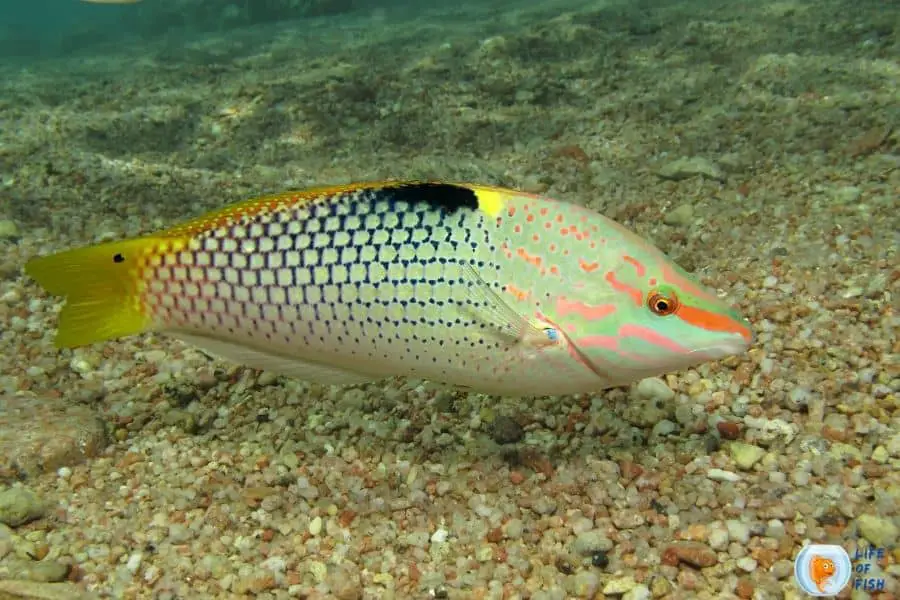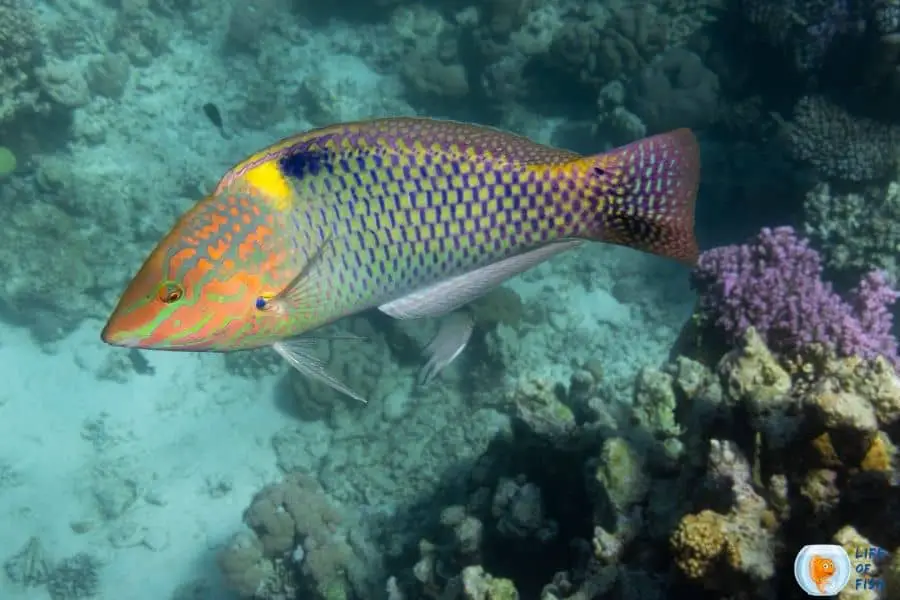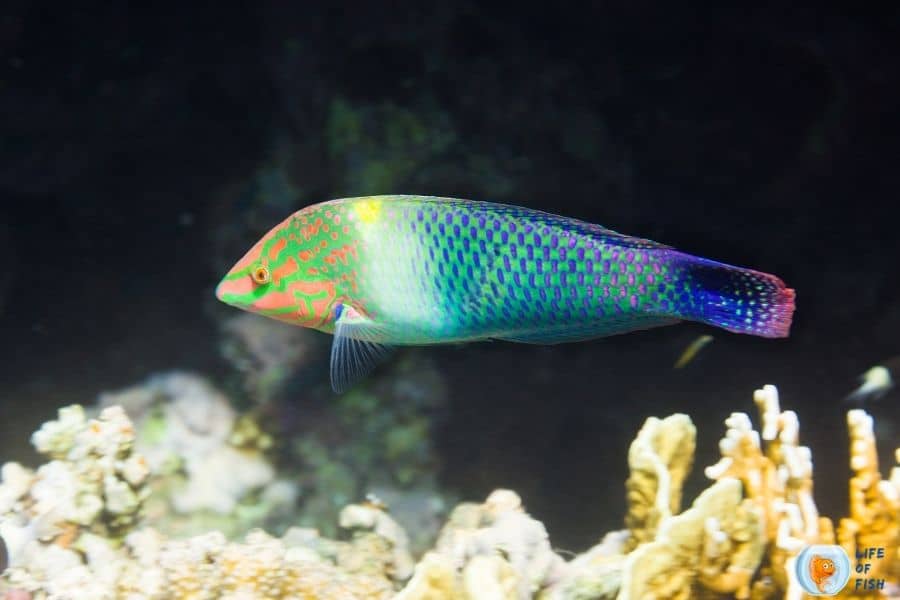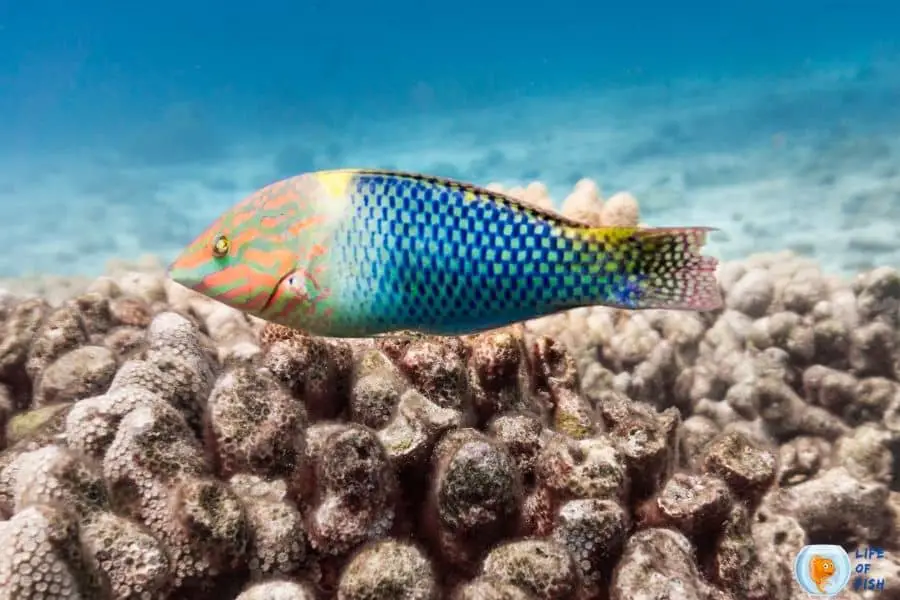If you’re considering adding a Checkerboard Wrasse to your aquarium, then you’re in for a treat. These fish are not only visually stunning, but they also have unique personalities that make them an interesting addition to any tank. Although these fish are abundant in the wild, they are relatively rare in the aquarium trade. Therefore, this fish will not be affordable one.

However, before bringing a Checkerboard Wrasse home, it’s important to understand their care requirements to ensure that they thrive in their new environment. In this blog post, we’ll explore everything you need to know about caring for them, including their ideal tank setup, feeding habits, and common health issues. So, let’s get started!
One Look Care guide
Jump To
- 1 One Look Care guide
- 2 More about Checkerboard wrasse?
- 3 Checkerboard wrasse appearance
- 4 How big do Checkerboard wrasse get?
- 5 Are they aggressive?
- 6 Their behavior
- 7 How long do Checkerboard wrasses live?
- 8 Checkerboard wrasse care
- 9 Checkerboard wrasse breeding
- 10 Special tips
- 11 How to feed Checkerboard wrasse?
- 12 What fish can live with Checkerboard wrasse?
- 13 Diseases
- 14 Related questions
- 15 Conclusion
| Scientific name | Halichoeres hortulanus |
| Common name | Checkerboard wrasse Marble Wrasse Hortulanus Wrasse |
| Care level | Moderate |
| Native to | Indo-Pacific ocean |
| Type | Saltwater fish |
| Color | Green to white with a black checkerboard pattern |
| Tank size | 125 gallons |
| Preferred temperature | 72-78 degrees |
| Other water parameters (ammonia, etc.) | pH level: 8.1 -8.4 Hardness: 8-12 dKH Specific gravity: 1.020 to 1.025 |
| Preferred salinity | 1.020 to 1.025 |
| Size | 27cm (11 inches) |
| Life Span | 15 years |
| Temperament | Semi-aggressive |
| Recommended tank mates | Large peaceful fish No other wrasse species |
| Preferred food | Carnivore Frozen and live food sometimes pellets and flakes |
| Feeding frequency | Several times per day |
| Breeding | Has not bred in captivity, Egg layers |
More about Checkerboard wrasse?
Scientifically known as Halichoeres hortulanus, Checkerboard wrasse is a fish that belongs to the Labridae family. You can find it in the Indo-Pacific ocean at a depth of 1 to 30 meters. It is also found throughout the Indian Ocean, Red Sea, Persian Gulf, and the Hawaiian islands. However, the They are not found in Japan or Australia. Also, these fish inhabit coral reefs, and their natural habitat is in the hard coral reefs, seagrass beds, and lagoons. It is a small-sized fish with an adorable pattern on its body.
Explore the fascinating world of wrasse fish with our in-depth guide!
Checkerboard wrasse appearance
Appearance-wise, these fish have a white or greenish body with a black to blue color hue on the edge of the scales, making a checkerboard pattern. The head is greenish with pink lines and dots that stretch to the base of the dorsal fin. A bright yellow spot appears at the border of the side and dorsal fin.
Some specimens may also have a black spot behind the yellow mark and another yellow spot at the end of the dorsal fin. The caudal fin is usually yellow, truncated, and typically tinged with pink, which may be faded or entirely blue.
The juvenile specimens have a completely different color pattern on their body. They are usually white or silvery with black stripes, dots, and patches that slightly resemble the checkerboard pattern.
At the base of the dorsal fin, a large black spot appears. The dorsal fin is yellow with a pinkish marble pattern, and the caudal fin is bright yellow. The head has a yellow hue with pinkish lines and dots that distribute until the base of the dorsal fin. The Pectoral, pelvic and anal fins of juveniles are white.
How big do Checkerboard wrasse get?
They are a small-sized wrasse species compared to other wrasses. A fully grown one has an average length of 27cm (11 inches).
Are they aggressive?
Although many online sources confirm this is a peaceful species, we’d like to say that this is a semi-aggressive species. The reason is these fish may be aggressive towards other types of wrasses. Further, they show male to male aggression.
It will cohabit well with other large fish species and even hide under the sand bed when frightened or threatened.
Their behavior
They are relatively peaceful fish that cohabit well with other large-sized fish if they are not similar looking. However, they may show aggressive behavior if not kept in a large-sized aquarium. These fish love to hide under the sand when frightened, threatened, or when they need to rest or sleep. They tend to move and reposition rocks and corals in the process of finding food.
These wrasses are carnivore fish and effectively hunt invertebrates, sea urchins, and worms from the aquarium all the time. This is the key reason these fish are not considered reef-safe.

How long do Checkerboard wrasses live?
They are long-living fish with an average lifespan of 15 years. Some specimens may live up to 25 years if they are well-maintained and fed with proper nutrition.
Checkerboard wrasse care
They are hardy fish species that can thrive in an aquarium. However, they require a large-sized aquarium with proper maintenance and care.
Size
They are relatively small-sized fish that can reach about 11 inches (27cm) maximum. However, they may have stunted growth in captivity if the tank is not large enough.
Tank size
You will require a minimum of 125-gallon tank to keep one of these fish. If you plan to keep more, you will have to increase the size of the tank accordingly.
How many of them should be kept together?
Interestingly these fish can cohabit well in a small group of their own species. However, the group must have only one male to several females. If you keep two male specimens in one tank, both will fight each other until one is driven away or killed. Additionally, you can also keep these fish in solitary or as a pair (male and female).
Tank setup
Since their habitat is usually near reefs and reef-associated areas, ensure that you have a reef or some kind of coral in your aquarium before you put this fish inside.
Substrate
These fish prefer to hide under the sand. So, it is essential to provide a deep sand bed for them. Alternatively, you can use fine-grained sand deep enough for your fish to hide or sleep under. The substrate should be at least 2 to 3 inches deep with a soft sand bottom. This fish prefers a dark substrate most of the time, but you can change its color depending on your tank décor.
Decorations
Since these fish prefer a lot of hiding places, make sure there is a variety of rocks and corals that will provide an appropriate home for them. But be cautious as these fish may reposition your decorations while looking for food.
Lighting
Since their natural habitat is under the water, you must maintain proper lighting in your aquarium to replicate its environment. You can pick out any type of lighting to offer the required light. But if you are keeping live corals, you should use T5 fluorescent or metal halide lighting.
Filtration
Since these fish are active swimmers, you need to have a strong enough filter to offer proper filtration. A canister filter will be a good choice for your fish.
Tank lid
Since these fish are jumpers, make sure you have a tight-fitting lid on your tank.
Water quality condition
Checkerboard wrasse is a fish that inhabits tropical waters in the wild. So you need to maintain at least 72-78 degrees Fahrenheit in your tank to ensure proper water quality. This fish prefers slightly alkaline water. You can check the pH of your tank by using a testing kit. Ensure that the alkalinity level is between 8-12 dKH, and the pH level should be about 8.1-8.4.
They are saltwater fish that requires at least specific gravity of 1.020 to 1.025. And you need an aquarium water conditioner to remove chlorine and chloramine from your aquarium.
Be cautious while adding salt to your tank. You can add salt to your tank only after conducting a water change to avoid changing the water parameters. Further, it is essential to change 20% water every two weeks in your aquarium to avoid the accumulation of harmful compounds in your tank.

Checkerboard wrasse breeding
They have not been bred in captivity like any other wrasse species. They may breed in aquariums, but they will require a lot of space, work, and effort for this purpose.
Based on data collected by scientists, these fish are egg layers that pair up for mating. The female lays the eggs near a coral or rock surface and lets the male fertilize them. One significant characteristic of wrasses is their ability to change sexes. Checkerboard wrasses are also hermaphroditic creatures.
They are all born as females, and some females transform into males when they mature.
Most of the time, it will be the dominant female of the group, and the reason can be the absence of a male specimen. A group of wrasses can lose their male specimen due to various reasons. This includes the male dying because of an illness, or another fish may also eat it.
The change of sexes is natural, and it has been observed in many species of wrasses. As for checkerboard wrasses, they change their sex when they reach 5 inches in length. That’s when these species reach their sexual maturity.
Male or female identification
Checkerboard wrasses show sexual dimorphism. They look different when they are females and males, but it is difficult to determine their sex based on their physical appearance only. To determine the sex of your wrasse, you must observe their behavior. You will be able to determine the sex of your fish if they are mature. When they reach their sexual maturity, you will see the difference between the male and female.
Appearance-wise, the males will be greener. But the females will be more greyish. However, the most distinct feature of male specimens is that they are more dominant and territorial. Males are also more aggressive.
Special tips
If you have a pest problem in your aquarium, Checkerboard wrasse can help you solve it. The fish is an excellent cleaner and will rid your tank of all types of pests, including bristle worms, flatworms, pyramid snails, and mantis shrimp. This fish that is better suited to a large tank. It’s advisable to keep it in at least 75 gallons to give your fish enough space for their swimming needs.
Like other wrasses, these fish are very sensitive during transportation. So, you need to be extra careful while moving the fish from one place to another.
How to feed Checkerboard wrasse?
Checkerboard Wrasses are not picky eaters, but they tend to be aggressive about food. To avoid competition for food, you should feed your fish at different times. Feeding these fish with live food will be ideal for their health, but it will also increase their aggressiveness towards other fish in your tank. Frozen or dried food is preferred for this species of wrasses.
While some specimens accept commercial food and frozen food, some are pickier. You will have to feed them live food to acquire their nutrition in such cases.
Picky eaters will mostly accept live food such as brine shrimp, mysis, and marine worms. You can also feed them with live Tubifex worms to supplement their nutrition. It is not wise to capture food from the wild, as it may contain parasites. You should buy them from reliable pet stores instead. Further, you will have to feed your fish several times per day to ensure that they are getting enough food.

What fish can live with Checkerboard wrasse?
You should carefully choose tank mates for them because of their relatively aggressive behavior. You should not keep these fish with other wrasse species (including their own species) unless you have a large enough tank. These fish tend to attack other wrasse species to establish their dominance.
These fish can cohabit well in a species-only tank if the tank has plenty of space and if there is only one male in the group. If there is no male specimen in the tank, the dominant female fish will establish their dominance by turning into males.
Checkerboard wrasse can cohabit with large, peaceful fish that doesn’t resemble them, such as lionfish, lion head tangs, triggerfish, pufferfish. They may not do well with smaller fish or invertebrates as they may eat them.
Diseases
They are hardy fish that do not get infected easily. The most common disease they get is marine ich. They also get Pseudochromis Syndrome.
These diseases are easily treated if the checkerboard wrasse shows early signs of infection. As the larvae hatch in the seawater, it is easy to treat them by adding salt to the aquarium. You can also treat the fish with commercial medicines meant for marine ich and Pseudochromis Syndrome. You should make sure you check the temperature before adding medications.
Further, it is essential to quarantine these fish if you add new specimens to your aquarium because they can carry diseases that will be transmitted to the other fish if they are not quarantined. You should separate them from other fish in your tank to avoid cross-contamination.
You can quarantine them by keeping them in a separate tank for about three weeks. Gradually increase the temperature of the quarantine tank to match the temperature of your main tank. You can safely introduce them to other fish after they show no signs of infection.
Special care is required to ensure that the checkerboard wrasse does not get stressed. You should avoid keeping them with aggressive fish because they may attack when stressed. You should provide them with hiding places to feel safe in the aquarium.
Related questions
Are Checkerboard wrasses rare?
They are not as rare as other varieties such as flame wrasses. You can find them in most large aquarium stores and online. However, the price of these fish is not low.
How much is a checkerboard wrasse?
They are not cheap. You will have to pay at least $50 for a juvenile fish—however, an adult fish costs around $175.
Can you keep checkerboard wrasses in reef tanks?
No, checkerboard wrasses are not reef safe. They will eat invertebrates and small fish.
How long does a Checkerboard wrasse live?
They can live for long if the water conditions are good. They have a maximum lifespan of about 15 years. However, some specimens may live up to 25 years.
Conclusion
Checkerboard wrasse is a gorgeous addition to your aquarium. But, you should have at least an intermediate level of knowledge as these fish are known to be aggressive to some fish. Therefore, you need to be careful with the selection of tank mates. If adequately planned before bringing these fish into your aquarium, checkerboard wrasse can bring colors and variety into your aquarium.
Read Next : Yellowfin Flasher Wrasse | A Fish Like No One Else | Orange Back Fairy Wrasse Care ( A Fairy In The Fish World )
